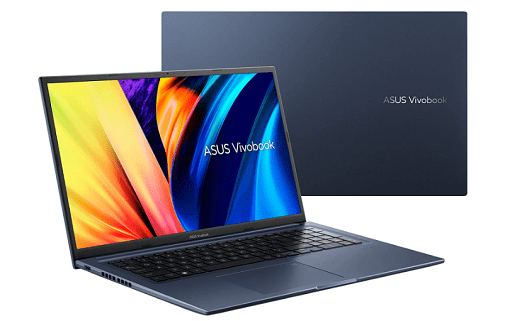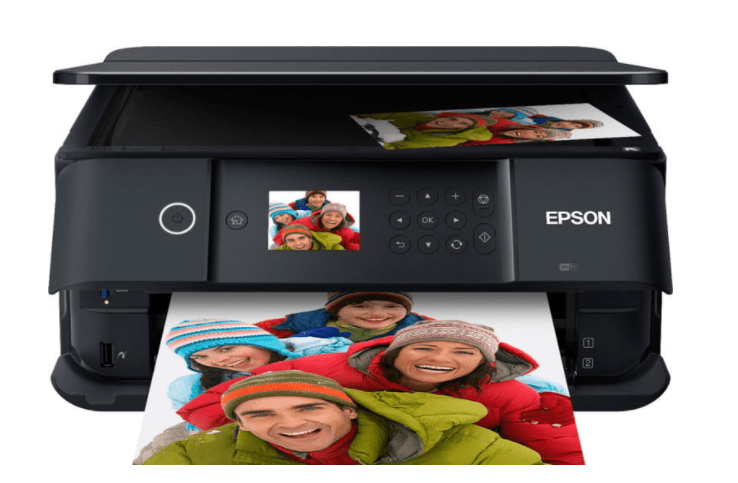Asus Vivobook 17X: the largest mainstream machine available today, provide the most screen real estate for multitasking and creative work. They also have larger chassis. However, they are not all built the same, with some aiming for low prices and high product performance, while others pack in the fastest components and best displays for creators.
The Asus Vivobook 17X falls into the first category. It has a low starting price of $630 and a maximum price of $1,000, with fast 45-watt Intel 12th-generation CPUs available. However, it is limited to integrated Intel graphics, which means it cannot run GPU-intensive creative apps or achieve high frame rates while gaming. When configured for around $700, the Vivobook 17X is an intriguing option, but the build quality, display, and battery life make it difficult to recommend at a higher price.

Asus Vivobook 17X display
The display is the most noticeable feature of a 17-inch laptop. It’s the entire point of purchasing such a large machine, and its quality has a significant impact on the computing experience. Unfortunately, the display on the Vivobook 17X is far below average, especially when compared to midrange and premium laptops, and even when compared to many budget machines we’ve reviewed in the last year or so.
The Asus is the cheapest 17-inch laptop we’ve tested in a long time, but even without direct comparisons, I’m confident in saying this is a subpar display for the price.
When I turned it on, this became clear. It wasn’t particularly bright, and the colors were subdued. The contrast appeared to be low as well. Even from the standpoint of productivity work, I was unimpressed. It also has an old-school 16:9 IPS display with a Full HD (1920 x 1080) resolution. That’s not very sharp, with visible pixelation in the text that’s made less appealing by the low contrast. And this display will fall far short of meeting the needs of even entry-level creators.
As previously stated, we haven’t recently reviewed any other 17-inch budget laptops, but we can compare the display to that of some other reasonably priced laptops. Simply put, the display on the Vivobook 17X is the worst we’ve seen in a long time. It fails to meet our 300-nit brightness standard, has a 660:1 contrast ratio that produces greys rather than blacks, and its colors are narrow and inaccurate.
The HP Envy 16 with the same CPU, RAM, and storage but a much faster Nvidia GeForce RTX 3060 GPU and a stunning higher-resolution OLED display is currently available for $1,400. Yes, it’s more expensive than my review unit, but it’s also a much faster machine with a display that’s out of this world.
The audio quality was on par with the video. Yes, the dual speakers were plenty loud, but the highs were grating and overpowering in comparison to the mids and lows. At full volume, there was also a significant distortion. For anything other than system sounds, you’ll need headphones or Bluetooth speakers.
You may also like Asus Vivobook S 14 Flip: Laptop for all homes
Asus Vivobook 17X discrete graphics
Several manufacturers, particularly in 14-inch laptops, have installed 45-watt Intel 12th-generation CPUs with integrated Intel Iris Xe graphics. This is a departure from the past when faster, more power-hungry CPUs were more commonly combined with discrete GPUs for maximum performance. It’s an unusual combination in a 17-inch machine like the Vivobook 17X, but it still promises superior performance.
The Vivobook 17X did, in fact, provide excellent performance, particularly for productivity workflows and less demanding creative tasks. It performed well in CPU-intensive processes such as our Handbrake test, which encodes a 420MB video as H.265 as well as Cinebench R23. If your creative work does not include applications that use the GPU to accelerate things, you’ll be pleased with the laptop’s performance.
If you use GPU-capable applications, such as Adobe’s Creative Suite, you’ll need to spend more money to match performance with display size. In the table below, I provide both balanced and performance results using the Asus thermal management utility, but the settings made little difference.
Of course, the display on the Vivobook 17X isn’t ideal for creative tasks in any case, so viewing the laptop as a multitasking productivity workstation is the best bet. If money is an issue, the laptop can also handle some less demanding creative workflows. Gaming will be limited to older games and esports titles, as well as low resolutions with reduced graphical detail, due to the integrated graphics.
The Vivobook 17X has a 50-watt-hour battery, which is small for a fast CPU, and a 17-inch Full HD display. As a result, its battery life was below average across the board, clocking in at only five hours in our web browsing test, ten hours in our video test (which isn’t bad), and less than seven hours in the PCMark 10 Applications battery test.
Overall, the results are not promising for all-day battery life. The power brick, on the other hand, isn’t particularly large, so transporting it shouldn’t be too difficult.
You may also like Lenovo Legion 5i Pro Review: Ultimate Performance for Gamers
Asus Vivobook 17X price
You can’t expect an all-metal build with incredible rigidity for around $700 for a 17-inch laptop. That is not the case with the Vivobook 17X, which has an aluminum lid and a plastic chassis.
Instead, there is some bending and flexing in the lid and keyboard deck. It’s not a cheap build by any means, but as I’ve mentioned throughout this review, it’s more appropriate at lower prices.
If you spend $1,000 on a laptop, you’re getting close to the price of laptops like the HP Envy 16, which aren’t quite as large but much better built. The hinge is also very tight, requiring two hands to pry open, but the lid is still a little wobbly.
The Vivobook 17X is a decent-sized laptop with thicker plastic display bezels that necessitate a larger chassis than a tiny-bezel laptop like the (much more expensive) Dell XPS 17. One significant advantage of plastic construction is its low weight of 4.63 pounds.
The aluminum and carbon fiber XPS 17 weighs 5.34 pounds, while an all-aluminum 17-inch laptop such as the (much more expensive) MSI Creator Z17 weighs 6.79 pounds. The Vivobook 17X is also thin for a large inexpensive laptop, measuring 0.78 inches versus 0.77 inches for the XPS 17.
The inclusion of Asus’s Antibacterial Guard treatment is an intriguing design element. The coating covers the entire laptop and uses silver ions to prevent bacterial growth by 99%. It is ineffective against viruses like COVID-19, but it is effective at keeping the laptop free of potentially pathogenic bacteria.
The Vivobook 17X has a rather plain appearance. The dark blue color is consistent throughout, with the exception of the black keyboard, and there is little bling. Even the chrome Vivobook logo isn’t as refined as it is on other contemporary devices. As with some other Vivobooks, Asus included its unusual black and white stripe along the bottom of the Enter key, which doesn’t add much to the look and instead distracts.
Asus included a very nice keyboard with sculpted keycaps and plenty of key spacing, even with the numeric keypad. While the switches aren’t as good as those on Dell’s XPS laptops, they’re excellent for an affordable machine. The touchpad is smaller than it could be, but there is plenty of room on the palm rest.
Despite this, it has a smooth, responsive surface, solid, quiet buttons, and reliable Windows 11 multitouch gesture support. It’s not surprising that there’s no touch display option.
There are numerous ports available. The issue is that some of them are falling behind. The USB-C ports, for example, do not support Thunderbolt 4, while the HDMI port is limited to HDMI 1.4. Thunderbolt 4 and HDMI 2.0 or later are available in machines under $1,000, so the price is not an excuse here. Wireless connectivity lags behind as well, with Wi-Fi 6 and Bluetooth 5 instead of the newer and faster Wi-Fi 6E and Bluetooth 5.2.
Finally, a fingerprint reader embedded in the touchpad provides Windows 11 Hello passwordless support. That’s my least favorite location because it reduces available scrolling space. But it worked perfectly.
You may also like ASUS ROG Zephyrus M16 Gaming Notebook
The Price that matters
The Vivobook 17X is similar to the Asus Vivobook S 14 Flip in that it is far more appealing at lower price points than the $1,000 configuration I reviewed. If you’re on a tight budget but require a large display, the Vivobook 17X is a good option.
At its higher price, neither the display nor the build quality is adequate. I don’t recommend the review unit, but at $730, the Vivobook 17X is worth a look. Keep in mind that you have to value that large screen because there are plenty of better options for smaller laptops at that price.
CamRojud may earn a certain commission on products purchased via our links, which supports our effort on this content.
Would you like to read more about Asus Vivobook 17X-related articles? If so, we invite you to take a look at our other tech topics before you leave!










